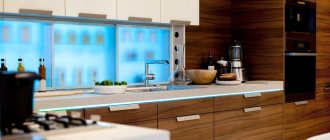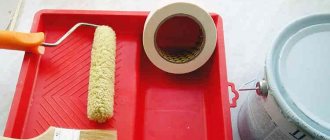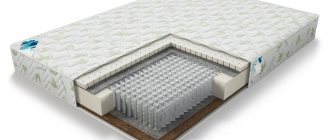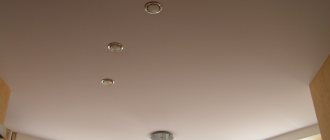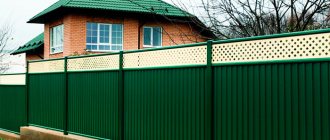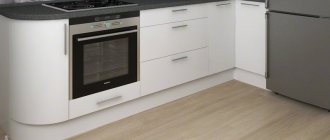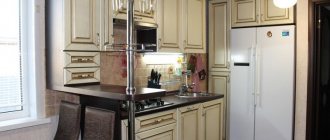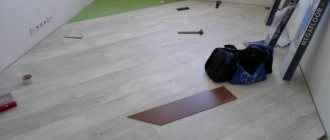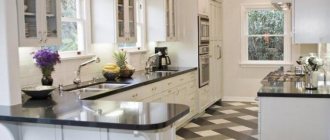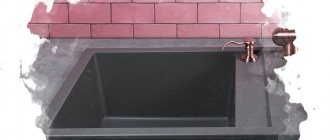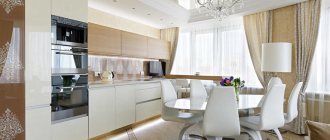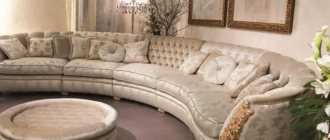What is better for the kitchen: MDF or laminated chipboard is a controversial issue. When arranging a kitchen, it is important to take into account a large number of nuances, one of which is the quality of the material for making furniture. Since not all people have the opportunity to purchase products made from natural solid wood, they have to look for a budget replacement. The most popular materials are MDF and chipboard. At first glance they are similar, but in fact they differ in production technology and some properties. Today we will look at the positive and negative qualities of these panels.
MDF or chipboard for the kitchen: which is better?
Description of material
The issue of using wood waste arose a long time ago. More than a century ago, the amount of such waste reached 60% of the total mass of sawn wood; today it has decreased to 10%. This was achieved thanks to their processing into composite materials that can be used in construction and beyond.
One of these materials is chipboard, the abbreviation for which is particle board. As the name implies, it is made from shavings formed during the woodworking process, as well as from crushed non-commercial wood, twigs and slabs. The particles are held together by synthetic resins, mainly phenol-formaldehyde.
How are chipboards made?
At the first stage of production, the raw materials enter special grinding machines, which should result in chips of a certain size:
- length no more than 40 mm;
- width no more than 10 mm;
- thickness up to 0.5 mm.
If round timber and large pieces of wood are used as raw materials, they are first cut into short pieces, cleared of bark, and then soaked. After which they are separated into fibers, which enter the crusher.
Shredded wood waste Source i1.wp.com
If you look at particle boards in cross-section, you can see that their inner layer consists of large chips, and the outer surfaces of smaller ones. Therefore, after primary crushing, part of the chips is sent for re-grinding to the fine fraction required for the outer layers.
The finished raw materials are dried and sorted by sifting. The large parts remaining on the sieve are returned to the crusher.
The prepared chips enter the chamber, into which binder resins are supplied along with them by spraying. With a strong air flow, wood particles rise into the air and mix with drops of resin, becoming covered with it on all sides. After that, the tarred mass is released layer by layer onto a conveyor belt using a dispenser, each layer (inner and outer) has a certain thickness.
Raw workpiece on a conveyor belt Source olandptm.ru
Directly on the belt, the solid chip carpet is cut into slabs, which are pre-compacted with a vibropress to give strength, heated and sent to a hydraulic press. There they undergo pressure and high temperature treatment, reaching up to 180 degrees. When heated, the binder resins harden, giving the compressed material high strength.
The hot sheets coming out of the hydraulic press are blown with cold air and cool naturally for several days, after which they are sanded and cut into standard size slabs.
The result is ordinary building boards, which, after marking and packaging, are sent for sale. If a manufacturer produces laminated chipboard material for the furniture industry, then another stage is included in the production process - lamination with a film based on thermosetting polymers.
The slabs are moved onto the cladding using vacuum lifts Source i.ytimg.com
Depending on the purpose of the material, production can be supplemented with other cycles - additional grinding, veneering, veneering, cutting dowels.
For reference! There is another method for making chipboard - extrusion, in which extruders are used instead of presses, squeezing prepared tarred chips through slotted heads. Extruded boards are much less dense and durable compared to pressed ones, which is explained by the loose structure and the perpendicular location of the chips relative to the plane of the sheet.
Types of slabs
Since the material is based on wood waste, it is not particularly moisture resistant. But replacing conventional resins with urea-melamine compounds and introducing hydrophobic polymer additives into the raw material makes it possible to increase the resistance of particle boards to moisture and produce moisture-resistant types of chipboard.
You can recognize moisture-resistant boards by their greenish color and markings (VDSP) Source chudopol.ru
Note! Moisture resistance does not mean that the material does not swell when directly exposed to water. It only better tolerates fluctuations in air humidity, maintaining stability of shape and size.
Tongue-and-groove slabs intended for cladding walls and ceilings and rough flooring are often made water-resistant. At the ends they have tongues and grooves, which make it possible to assemble an almost monolithic coating by tightly joining the elements to each other.
VDSPSh marking Source prom.st
In addition to solid ones, perforated extrusion plates with through holes in the form of pipes are also produced. That's what they call tubular. They are not found on sale, as they are used to make doors, acting as an internal filler. This material has the following special properties:
- light weight - it is 50-60% lighter than conventional slabs of the same thickness;
- high sound insulation characteristics;
- increased thermal insulation;
- dimensional stability.
These qualities are exactly necessary for the production of inexpensive but high-quality doors.
Tubular slabs made from wood chips Source i.ibb.co
Veneer boards and laminated chipboards stand apart: what they are is easy to understand by looking at the cabinet furniture in the house. Outwardly it looks wooden, but in fact it is made of chipboards with a decorative coating. Such coverage may include:
- veneer of different types of wood;
- paintwork;
- melamine film or film made of thermosetting polymers.
The last type of material is abbreviated as laminated chipboard, meaning laminated chipboard. The film is paper with a pattern or wood pattern printed on it, impregnated with resins. It is applied to the sheet by hot pressing, during which the resins melt, penetrate into the structure of the board and firmly connect the cladding to the base. This coating gives the material decorative properties, and also increases its resistance to wear, moisture resistance and surface hardness.
A press for gluing film can give the surface a certain texture that imitates the structure of different materials, significantly increasing the decorativeness and visual appeal of furniture and finishing boards.
What is MDF?
MDF was first invented in America back in the 60s of the last century, and in Russia this material appeared only in the late 90s. MDF boards are made from wood chips, ground into very small chips - it is practically split into fibers. Then these chips are thoroughly washed, excess dirt is removed, dried, and then pressed under high pressure.
As the fibers heat up, they begin to release a natural resin called lignin. It is this substance that glues the chips together, resulting in very strong slabs with a fine structure.
MDF board manufacturing process
The pressed slabs are then carefully sanded - this is done in order to remove any excess sagging from the surface. In addition, at this stage, panels of various thicknesses are formed. After which the surface of the slabs undergoes finishing treatment, which allows you to obtain a wide variety of materials for work.
Table 1. Types of MDF finishes
| Type | Description |
| Sanded | Sand only one side of the slab or two at once. Putty and various types of paint can be applied on top of such material. This is the simplest and most common type of MDF, allowing the buyer to decide on the finish of the slab. |
| Laminated | A special polymer film is applied to the surface of the plate. In this way, only one side or both are processed. The film has an aesthetic appearance that imitates the structure of various types of natural wood, which is why such boards have become especially popular among furniture makers. |
| Veneered | A thin layer of natural wood is glued on top of the slabs, so that the appearance of such material becomes similar to natural wood. Of course, due to such processing, MDF acquires a higher cost, but greater attractiveness and nobility. |
| Varnish coating | A thick layer of varnish is applied to the slab, making the material resistant to moisture. However, this is not the best option for the kitchen, because fingerprints will constantly appear on the surface. |
MDF kitchen set
The main advantages of MDF include the following:
- Safety for the health of residents, because in the process of its production no harmful chemical compounds or formaldehydes are used.
- It has good resistance to various mechanical damage.
- The furniture is easy to care for - this material has a smooth surface that does not absorb dirt.
- Resistance to high air humidity.
- This material is not affected by fungi.
- Easy to process even at home - MDF can be used to make structures of any shape.
- You can find a wide variety of colors of MDF boards on sale, which allows each person to choose the best option for themselves.
There are a large number of MDF colors available
There are also some disadvantages of this material:
- The obvious disadvantage is the rather high cost of the material, but it is still lower than that of natural wood.
- Some note that when exposed to too much heat, MDF can separate into layers, so it should be protected from such negative effects.
- Furniture does not react well to aggressive alkali.
- Untreated surfaces have poor resistance to moisture. Thus, the material absorbs water, which is why it begins to swell after some time.
- Scratches appear quickly on glossy surfaces, so it is not recommended to use metal brushes for cleaning. A problem that has already appeared can only be corrected by painting, and the entire surface will have to be painted.
- Due to constant fumes in the kitchen, the varnished countertop becomes faded and matte.
- After some time, the material will still lose its original strength, which can cause cabinet fittings to become loose.
Video - Veneer facades for the kitchen
Prices for different types of MDF panels
MDF panels
Video description
How lamination occurs can be seen in the video:
Dimensions
The main document regulating the sizes of chipboard and laminated chipboard sheets is GOST 10632-2014, according to which domestic manufacturers produce boards with a length of 2440 mm and a width of 1830 and 1220 mm. Another popular standard is 2750mm x 1830mm. Material thickness from 10 mm to 25 mm.
On a note! Foreign-made slabs with dimensions of 2800 mm x 2070 mm are also supplied to the Russian market.
Laminated panels can be faced on one or both sides, leaving the ends open. If necessary, you can cover them yourself with edge tape. Also, construction hypermarkets sell ready-made edged panels of non-standard sizes, intended for self-production of shelves, countertops, cabinets and other furniture.
Furniture panels made of laminated chipboard Source volga-plit.ru
See also: Catalog of companies that specialize in finishing and paint materials and storage systems.
Characteristics of the cost of materials
The most budget option is chipboard. Mostly shelves are made from it. If you make a facade, be sure to apply lamination. This kind of furniture is the most inexpensive.
Advantages – the cost of such furniture. The absence of expensive accessories also reduces the cost of purchase. For this price category the furniture is quite acceptable.
It is imperative to choose good chipboard.
MDF is covered with a special vinyl film for facades and it can be:
- matte;
- glossy;
Glossy
- with effects.
If the film is exposed to heat, it will peel off. It is recommended to choose high-quality film and good adhesive. Such furniture will last 5-7 years.
Facades are easily scratched. However, kitchens in this price category also have a corresponding service life.
Classification
Since our country produces mainly pressed slabs, we will tell you how they are classified.
- Emission class.
This parameter reflects the degree of environmental friendliness of the material, its ability to release free formaldehyde vapor into the air. There are classes E0.5, E1, E2. The latter is not allowed for indoor use, since the content of harmful substances in it exceeds the permissible limit.
- Strength.
Reflects resistance to deformation and warping, depending on the density, which for this material ranges from 550 to 750 kg/m3. According to the strength indicator (P), the slabs are divided into two groups. P1 means that such sheets can be used as auxiliary building materials, and P2 in the laminated chipboard marking means that these are durable boards for constructing partitions and other indoor structures, as well as for making furniture.
- Surface quality.
A parameter that determines the grade of the material. Grade 1 is assigned to slabs without visible defects, grade 2 allows for some surface damage. Chipboard with serious defects is not assigned a grade.
1st grade chipboard Source yandex.net
- Type of surface – polished and unpolished.
Pros and cons of laminated chipboard body material
The advantages of chipboard are as follows:
- fairly inexpensive in cost;
- covered with many types of laminate;
- endurance to the influence of high temperature;
- it is very easy to process in the manufacture of cabinet furniture.
laminated chipboard
The disadvantages include:
- strong looseness of matter;
- poor retention of screws, especially when reused;
- nails are practically not held inside the slab;
- service life is no more than 10 years.
In the manufacture of this building material, the shavings may contain substances that emit formaldehyde in moderate quantities. They are quite harmful to humans.
This modern material is produced in large factories from wood shavings. It is ground and mixed with resin. Subsequently sawn into slabs.
Advantages and disadvantages
Any material has pros and cons. If you compare chipboard with wood and its other derivatives, you can better evaluate and understand its properties.
The environmental friendliness of particle boards is incomparable to natural and laminated wood, plywood and MDF, since they contain toxic binders that emit formaldehyde, which is hazardous to health. But only sheets with emission class E2 are dangerous, so they are prohibited from being used indoors. Class E1 contains a small amount of formaldehyde allowed by sanitary standards. And chipboard of class E0.5 practically does not emit free formaldehyde, which allows it to be used even in children's rooms.
The bending strength of the panels is also lower than that of wood; they hold fasteners less well, but the material itself does not crack or dry out over time.
Note! When screwing self-tapping screws into the end, the maximum load on them is reduced by almost half.
Under constant dynamic loads, the fasteners quickly become loose or tear out part of the material Source i0.wp.com
The choice of material depending on the kitchen design
Depending on the design of the overall kitchen interior, various lumber is used. Of course, the visual differences between laminated chipboard and MDF are small, but designers have the following opinion regarding the style of the kitchen and the materials for it:
- Classical. In this case, it is better to give preference to untreated MDF boards, since they can be painted independently and given an unusual appearance using the patina technique.
- Art Deco. Since the quality of the glossy surface of laminated chipboard is slightly better, it is recommended to use this material. However, MDF is also perfect for such an interior.
- High tech. Since this style does not have various figured facades, it is quite possible to use laminated chipboard.
- Provence. As in the case of the classic style, finely dispersed material for painting is most suitable.
MDF kitchen in classic style
Areas of application
Chipboard and laminated chipboard - we found out what kind of material they are. And now it becomes clear why it is of such interest among builders and furniture manufacturers. It is in these areas of production that it is used most often.
In repair and construction work, non-laminated boards of class E2 are mainly used, with the exception of finishing interiors. They are indispensable where large parts with a large surface area are needed. For example:
- during the construction of partitions;
- when facing frames;
- when leveling walls;
- when constructing solid bases for floor coverings;
- for the manufacture of formwork.
Smooth and durable slabs make ideal formwork. Source i.ytimg.com
The main condition for using the material is to exclude its contact with moisture. Therefore, external cladding of facades or frame buildings is allowed only if hinged ventilated facades are created; when laying on the floor, high-quality waterproofing is required from below, and the formwork elements made of chipboard are protected from water by an impenetrable film.
Panels for cladding walls and ceilings, and tongue and groove slabs for floors are made from laminated chipboards and slabs with other decorative finishes. The latter allow you to quickly level the surface, while simultaneously giving it an aesthetic appearance, eliminating the step of creating a final coating.
General requirements for the use of furniture
Despite the fact that manufacturers promise that kitchens are resistant to high temperatures, you should not expose furniture made from MDF or laminated chipboard to temperatures exceeding 75 degrees. Due to this impact, the surface may be deformed, so it is not recommended to place heating devices on the countertop.
If the kitchen set is constantly exposed to sunlight, then after a few months it may become pale (this is especially true for furniture made of laminated chipboard). You should not allow the slabs to be regularly soaked in water - in such conditions, even the most durable material will rapidly swell.
You will need to keep surfaces clean
The following surface care rules must be followed:
- It is advisable to regularly wipe the furniture with a dry cloth to remove dust; in addition, you can purchase a special product for delicate cleaning;
- if water gets on the surface, it should be removed as quickly as possible with a well-absorbing cloth;
- You should not use wax for such materials, which is used to polish natural wood - it will not be absorbed and will remain in a greasy layer.
MDF and laminated chipboard react poorly to wax intended for solid wood. If this rule is neglected, the laminated surface may become stained and even deformed. When cleaning, you should not use various products with a high acid content.
MDF kitchen combined with living room
Since both materials are resistant to fungi, furniture can stand in dry rooms for many years, and no additional treatment is required in this case.
If you don’t know what to put and where, how to place a set with everything you need in a small kitchen, we advise you to carefully study the special article and then apply the knowledge gained from it in practice.
Furniture manufacturing
Laminated panels are in great demand in this area. Everyone is well aware of what laminated chipboard is in furniture. These are all visible parts of upholstered and cabinet furniture: walls, shelves, tabletops, bed frames, as well as cabinet fronts in the inexpensive segment. Hidden parts and those located under the upholstery can be made of slabs without a decorative coating.
Furniture made from chipboard is the most affordable Source mblx.ru
In terms of manufacturability in the manufacture of furniture, this composite material is superior to wood in many respects, especially when it is necessary to create large-sized structures. It is not needed:
- plan;
- polish;
- paint;
- splice or glue together several elements to produce wide parts.
To make furniture from laminated chipboard, it is enough to cut and cut out the parts, mark and drill holes for fasteners, and use it to assemble the product and install the fittings. But this material forces us to include an additional stage in the technology, which is absent in the production of wooden furniture. We are talking about finishing the ends. This can be a problem when making it yourself; in production, the edge is glued using special equipment.
Which material is suitable for kitchen furniture: comparison
To understand whether it is better to buy furniture made from laminated chipboard or MDF for the kitchen, you need to compare their positive and negative qualities.
Durability
Of course, when purchasing various pieces of furniture for the kitchen, we plan to use them for many years in a row, so it is necessary to choose the most durable material. As we mentioned above, low-quality furniture will quickly become unusable, and the kitchen will have to be replaced every two or three years, which is completely unprofitable.
MDF has better wear resistance
Furniture made from MDF is characterized by the highest durability (this feature is due to the almost natural composition of this material), and structures made from laminated chipboard will quickly lose their original appearance. If you provide good care for MDF furniture, it will definitely serve you for many years.
Resistance to various damages and negative impacts
Kitchen furniture must be resistant to various impacts and other damage. Of course, products made from MDF have better resistance to wear and oil stains. However, such a surface will suffer from constant exposure to steam or any liquid, and this will become noticeable within a few years. Furniture made from chipboard is less likely to deform under such conditions.
Laminated chipboard is stronger due to the synthetic resin in its composition
Otherwise, I would like to note that furniture deteriorates and breaks with equal frequency due to various mechanical damages, so it is difficult to select the best of the two materials. Note that laminated chipboard has a higher resistance to scratches, moreover, these surfaces can be washed without fear even with strong chemicals.
Environmental Safety
The content of toxic components in the composition negatively affects human health, so this point cannot be ignored. And since laminated chipboard still contains formaldehyde, albeit in small quantities (E1), purchasing such furniture is a risk, especially if kitchen furniture is made from it. Therefore, despite the large number of positive qualities, many refuse this lumber.
Chipboards may have a specific odor due to formaldehyde
Note! We should take a short digression to understand how synthetic resin affects health. This poison affects the nervous system, respiratory organs, liver, and kidneys. In addition, the substance irritates the mucous membranes of the eyes and provokes an allergic reaction.
The use of MDF in the kitchen, in turn, does not in any way affect people’s well-being, so if we evaluate materials on this point, then MDF is clearly the leader.
Aesthetic features
The attractive appearance of a kitchen is sometimes the main criterion by which it is chosen. Here, the two materials we are considering do not have any particular advantages over each other, since the modern furniture industry offers a lot of kitchen models made from both MDF and laminated chipboard. The choice is always a matter of taste, so for each buyer the conclusion about the external attractiveness of such furniture will be individual.
An example of an aesthetic kitchen made from chipboard
But, if you want to purchase a kitchen with various shaped elements, then of course you should choose MDF - laminated chipboard, due to its greater rigidity, is not suitable for the manufacture of such furniture elements. I would also like to note that laminated chipboard has a wide variety of shades, and if you are looking for furniture in bright or unusual colors, then you should take a closer look at this material.
Video description
The entire production process of such furniture, from processing raw materials to assembly, is shown in the video:
Affordable cost is not the only advantage of such products. Unlike wood, they maintain stable dimensions when air humidity changes, and do not warp or crack when temperature fluctuates.
In recent years, laminated chipboard in furniture production has begun to replace a more environmentally friendly material - MDF boards (fine fraction of wood chips). It is made from fine sawdust without the use of toxic resins. They were replaced by natural substances - paraffin and lignin, which is a natural polymer found in wood.
MDF is stronger and more ductile than particle boards, it can be milled and other fine processing, but is much more expensive.
MDF is more dense, this can be seen in the cut Source gearbestblog.ru
Advantages of MDF over laminated chipboard
So, after comparing two types of wood-based boards, we can come to the conclusion that, in general, MDF differs from chipboard for the better. The advantages of MDF are as follows:
- no chips are formed on the edges, in places where screws are tightened;
- is characterized by high density and strength;
- the material is environmentally friendly;
- more resistant to moisture than laminated chipboard;
- MDF can be bent, milled, and therefore create beautiful shapes and designs.
The advantages affect the price. Typically, the cost of fibreboards is higher than that of particle boards. If MDF is combined with metal, glass, made in accordance with the original design solution, and decorated, then its price increases even more. At the same time, such furniture, whether it is in the kitchen or in the bedroom, requires more careful care.
What is the difference between children's furniture made from MDF and laminated chipboard?
To successfully organize a room for babies, it is important to take into account the advice of doctors. When the baby grows out of his cozy crib. It's time to take care of arranging the space in his room.
To do this you need to choose furniture that will:
- comfortable;
- comfortable;
- safe.
A grown-up baby already needs:
- a table at which he will create the first masterpieces of his creativity, and later do his homework;
- comfortable bed;
- wardrobe with drawers for clothes and toys.
All furniture for a children's room should be made from environmentally friendly materials. In addition, you cannot place furniture in a child’s room if the child is allergic to one of the materials from which it is made.
The first thing you need to pay attention to when choosing furniture for a nursery is the quality of the furniture. Products must be certified. The quality must be factory made. The more modules, the more opportunities to create the ideal children's room with areas for relaxation, games and activities.
Furniture for the nursery
It is necessary that all furniture is suitable for the child’s age. So that he can get his things or toys from the closet or table.
The chair and table should be such that the baby’s posture develops correctly.
If the size of the children's room does not allow placing full-fledged furniture, the solution would be to purchase modular furniture - a transformer. For example, choosing a bunk bed helps create personal space for each child. It can have a built-in linen drawer and a closet.
Bunk bed
Do not clutter the room with unnecessary pieces of furniture. Only necessary things. If you choose the right furniture, children will feel happy and try to complete tasks on time.
Environmentally friendly materials for facades and product bodies:
- chipboard;
- mdf;
- natural wood.
E1 is the highest safety class of chipboard. If furniture for children is made from this sheet, you don’t have to worry about the quality of the panels. This material is moisture resistant. It is perfect for furniture frames and shelves. It is covered with chipboard with PVC film.
E1
MDF is better suited for making furniture doors. This material is durable and wear-resistant. It is not afraid of moisture and does not deform over time. Resistant to scratches and dirt.
Tips for choosing laminated chipboard
When choosing laminated chipboard, special attention should be paid to appearance. The sheet must be smooth, without chips, cracks or scratches. The edges of the laminated board should not differ in thickness. This fact indicates that the slab was exposed to moisture. This material is unsuitable for making furniture: the swollen base makes it difficult to use fastening devices.
Pay attention to the cost of chipboard. If the cost is unreasonably low, ask why. At a promotional price, this is an illiquid product that is completely unsuitable in the furniture industry. In some cases, laminated chipboard with minor defects may be suitable, for example, in the construction industry, and then the low cost will allow you to win.
